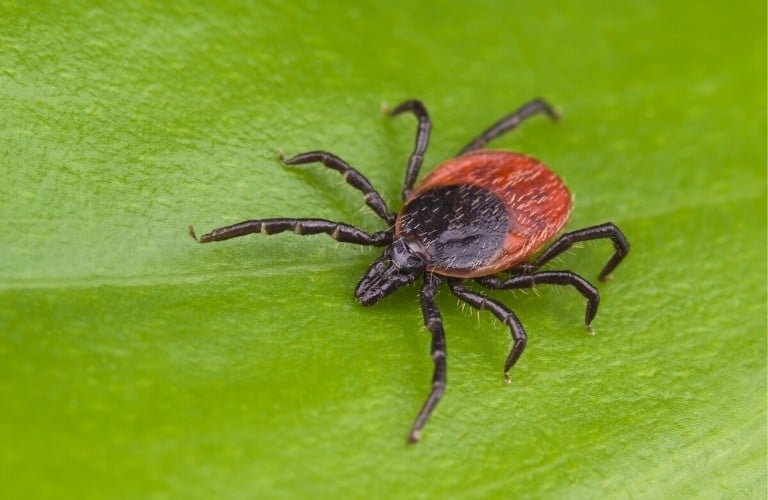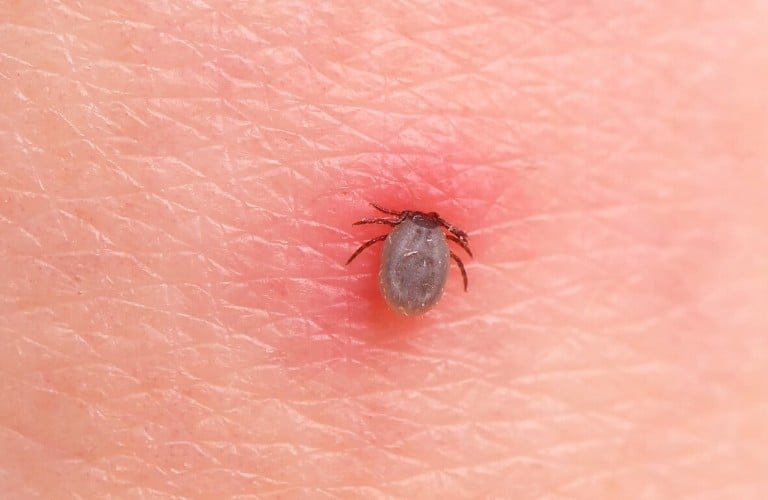Ticks are often hard to find until it’s too late. You usually spot them once they’ve buried their head into your skin, which is dangerous since they can pass diseases to you.
If you enjoy spending time outside or have children or pets, ticks can be especially worrisome.
How do you get rid of ticks? To eliminate ticks, keep your yard free of debris, cut the grass frequently, prevent animals from entering the property, eradicate rodent populations, and use natural treatments containing essential oils or neem oil. As a last resort, pesticides may be used as well.
Removing ticks one by one from your or your pet’s skin with tweezers is a tried-and-true removal method, but if your house or yard is infested with them, you have to think bigger.
We’ll show you how to effectively banish these potentially harmful pests from your home and property and how to keep them from coming back.
Identification
Ticks are small, ranging between 1 and 10 millimeters. For size reference, that’s somewhere in between the tip of a sharpened pencil and a green pea.
Ticks are usually brown or black. The lone star tick, one of the most common ticks in the United States, is brown with a white dot on its back.
Ticks are usually oval-shaped and have eight legs. The head is distinct from the oval body, and when the tick has bitten you, you won’t see its head because it’s buried in your skin.
Removal Methods
| Method | Estimated
Cost |
Natural | Odor Free |
| Natural spray (indoor) | $10 | ✅ | |
| Natural carpet powder | $10 | ✅ | |
| Manual device | $8 | ✅ | ✅ |
| Natural tick spray (outdoor) | $35 | ✅ | |
| Neem oil | $25 | ✅ | |
| Diatomaceous earth | $20 | ✅ | ✅ |
| Pesticide tick spray | $15 | ✅ | |
| Tick control tube | $20 | ✅ | |
| Pesticide granules | $10 | ✅ |
The Best Way to Eliminate Ticks
The best way to remove ticks that have bitten you is, according to the Centers for Disease Control:
- Use tweezers and grab the tick as close to the skin as possible. You can also use the Tick Twister tool we recommend below.
- Without applying too much pressure, pull straight up. Don’t pull to the side or twist because that could leave part of the tick in your skin.
- Dispose the tick in a sealed container, wrap it up in tape, or flush it in the toilet. Don’t crush it!
- Wash the bitten area with rubbing alcohol or with soap and water.
The best way to eliminate a tick infestation is by using a natural tick spray, such as Vet’s Best Flea and Tick Home Spray.
To use it:
- Remove children and pets from the room you need to spray. Natural sprays are much safer than pesticides, but you should still keep kids and pets out of the room.
- Ventilate the room as indicated on the product’s label. You might want to ventilate anyway just because the scent of natural oils may be too strong.
- Spray the floors, furniture, and pet beds as directed on the product. Vet’s Best Flea and Tick Home Spray is safe to use on pets, so you can even spray Fido after you’ve treated the room.
- Let everything dry before you allow children and pets to enter the room and before you sit on the furniture.
- Vacuum the floors a few hours after the spray has dried so you can pick up dead ticks.
- Repeat this process as needed.
Basic Guidelines
The most effective course of action in your battle against ticks is to treat them at the source and avoid bringing them indoors.
Ticks live in grassy, cool areas and are only brought into your home after hitching a ride on you or your pets.
(For more specific details on where you’re likely to see ticks in your yard or on a hike, read this article.)
Preventing this requires a few extra steps, but they’re super easy to follow.
Cover Yourself Before Going Outside
If you live in an area with lots of ticks (check these maps before you go out), be sure to cover up your skin.
Wear long pants and tuck the pant legs into your socks. Be sure to wear shoes, too.
Ticks also live in trees, so wear a hat and tie up long hair if you’re going to be around trees. The less access they have to your body, the better.
Check for Ticks Before Going Inside
This step is particularly important during the warm months of the year when ticks are most active.
(Find out more about the tick’s life cycle and which months their activity will spike here.)
- Check your clothing: Ticks can land on you and crawl on your clothes as they search for skin to latch onto.
- Check your body: Ticks prefer warm and moist areas. As gross as it may be, check all the sweaty areas thoroughly since they think those places are prime real estate. But they’re not picky – check your legs and arms too.
- Check your pets: Your pet’s legs and belly are the most common places for ticks to land on. They might travel to their neck and back, so you should check every part of your pet.
Shower Straight After Coming Inside
Whatever you don’t find and pick off yourself, you’ll be able to remove in the shower.
Use a washcloth or loofah to scrub since they need to be removed with some force.
Hot water is recommended since ticks don’t like the heat. They’ll be more likely to detach if they’re hit with hot water.
Tidy Up Your Yard
Ticks like to live in covered areas that are cool. Yards are great places for ticks to live and multiply in if you don’t keep them tidy.
- Remove piles of leaves: Ticks appreciate a hefty pile of leaves or grass clippings. After raking and mowing your yard, remove the debris from your yard.
- Keep your grass short: Ticks like long grass but won’t live in it if it’s too short. Regularly mowing will deter them. Be sure to get the grass around playgrounds and fences also.
- Remove debris: Debris can be anything that sits still for too long, whether that’s an old tire, trash cans, furniture, or forgotten toys. Nothing should be left in your yard for so long that grass can grow around it.
Keep Stray Animals Out
Ticks are brought onto your property by animals, whether it’s mice, stray dogs and cats, or your pets.
Keep stray animals out by using a fence and removing debris in flower beds since animals like to hide in hidden areas.
Although some animals will eat ticks, these critters are just as likely to become tick prey as they are to gobble up a couple of ticks.
Ticks strike fear into the hearts of many. Don’t miss out on important information that will help you protect yourself. Click here to see our entire lineup of tick articles.
Natural Solutions to Get Rid of Ticks
Fortunately, we can fight nature with nature. There are several natural products you can use to get rid of ticks.
These options are so much safer than toxic chemicals and are great if you have kids and pets running around your home.
Most natural products contain essential oils, so if anyone is allergic to those ingredients, be sure to check the labels before you bring them into your home.
They aren’t toxic products, but they can still be irritants.
Indoor Infestations
Indoor tick infestations can be the most troublesome. When ticks are crawling around, they take your peace of mind and prevent you from relaxing.
Try these natural products to get rid of ticks in your home.
Indoor Tick Spray
Indoor tick spray is one of the best methods to use because natural sprays are super versatile.
We recommend Vet’s Best Flea and Tick Home Spray because it can be used on floors, furniture, and dogs.
Dogs are usually the culprit of a tick infestation, so this spray allows you to kill ticks at the source.
What allows a natural product to kill ticks? Vet’s Best uses peppermint oil, eugenol, and sodium lauryl sulfate.
Eugenol is derived from nutmeg, cinnamon, basil, and other plants, and sodium lauryl sulfate is a naturally occurring organic compound that’s typically used in cleaning products.
All three of these ingredients can kill or repel ticks and aren’t harmful to humans.
While the products mentioned here are great for eliminating ticks around your home, keeping them off of you is equally important. We show you the best sprays to use here.
Carpet Powder
Carpet powder is another great natural option to get rid of ticks inside. Ticks like to hide in carpets, so carpet powders will infiltrate their space and kill them.
Natural Care Flea and Tick Carpet Powder is an excellent product to use because it only contains natural ingredients.
One thing to note about this product is that it includes geraniol, an alcohol found in rose oil and citronella oil that can be irritating to people and pets.
Every person and pet will react differently to it, so be careful when using it.
As with any other tick treatment, keep kids and pets out of the room while you’re using it.
It’s a powder, so dust will go into the air, which can irritate the eyes and respiratory system.
Cover your face while you apply it and ventilate the room according to the directions.
Remove Individual Ticks
While you wait for products to kill ticks around the room, you’re probably going to find a few ticks that found their way onto you.
Terrified of what might happen if you are actually bitten by a tick? This information will give you some peace of mind.
Rule number one: don’t panic! Yes, ticks can transmit diseases, but it usually requires the tick to be attached to you for more than a day for the diseases to be transmitted.
You can use tweezers to remove ticks, but we also recommend a specialized tool like the Tick Twister Tick Remover.
This product includes two sizes of tools, so you can choose the one that fits the tick the best.
The tool allows you to grab the tick without squeezing it so you can remove it in one piece.
The CDC advises to pull straight up when removing ticks so their mouthparts won’t break off in your skin, but this product recommends to twist because that encourages the tick to let go.
We suggest following the CDC guidelines, but the Tick Twister is still a great tool since it will prevent you from squeezing the tick, which tweezers can’t do.
Head over to this article to learn alternative methods for tick removal as well as what not to do.
Outdoor Infestations
Outdoor infestations inevitably lead to indoor infestations since they’ll eventually land on someone who will bring them inside.
There are plenty of natural solutions you can use to fight them off so you don’t have to disrupt the environment.
Outdoor Tick Spray
Once again, tick spray proves itself to be highly effective. Wondercide Natural Flea & Tick Spray is a great choice because it doesn’t contain toxic chemicals and it’s easy to use.
You attach the bottle to a water hose and spray your yard, and that’s it. You don’t have to wait for it to dry before walking into the yard as the ingredients are safe and all natural.
Wondercide relies on cedarwood oil and soap to kill ticks.
As with any product, you shouldn’t spray around children and pets even though the product is safe for them to walk in.
Cedarwood oil could be an allergen for some, so be careful when using this product.
Neem Oil
Neem oil is a “miracle oil” in the garden. It comes from the neem tree and has several uses, such as pest control, shining leaves, and as a fungicide.
Using it as a form of pest control will also benefit you in several other ways.
To use it against ticks, apply it to plants that are in the area where ticks are congregating.
You can also rub it onto your skin to keep them off of you while you’re working in the garden.
If you want to use it on your dog, you need to dilute it with a carrier oil for it to be safe.
We recommend Neem Bliss Organic Pure Neem Oil because it isn’t diluted and doesn’t have any other ingredients or water mixed into it.
Diatomaceous Earth
Diatomaceous earth is another natural remedy that works wonders. It’s safe to use around people and pets, but as insects of all kinds walk across it, it kills them by dehydration.
Spread it around your yard, flower beds, leaf piles, and wherever else ticks live, and their population will go down after a few days.
It takes time for the ticks (and other pests) to dehydrate completely, so it’s not a quick fix, but it’s still a good one.
This Food Grade Diatomaceous Earth is pure and doesn’t have anything added to it. It’s food grade, so it’s safe to use in barns around animals or vegetable gardens.
It’s a 10-pound bag, so it’ll last you a long time, and you can continue using it as a preventative measure once all the ticks are gone.
It will also kill any other pests that walk across it, so you may want to spread it around your entire property.
Pesticide Solutions to Get Rid of Ticks
Pesticides aren’t the safest option to use around your home, but they are effective. You should use pesticides after you’ve tried natural solutions.
If you have any worries about using the products correctly, you should contact a professional exterminator so they can do it for you.
Pesticide Spray: Terro Tick and Flea Yard Spray
Similar to the natural spray we mentioned above, Terro Tick and Flea Yard Spray hooks up to a water hose so you can distribute it around your yard and patio.
It kills ticks on contact, so it’s a quick way to take care of an infestation. It’s recommended that you allow the product to dry before you allow anyone to enter the area.
When you’re using this Terro Tick and Flea Yard Spray, be careful not to let it touch your skin or get in your eyes.
Tick Control Tubes: Thermacell Tick Control Tubes
These tubes are probably one of the safest ways to use pesticides.
You don’t have to worry about spraying pesticides all over everything. Instead, place the tubes in areas where you usually see mice.
Thermacell Tick Control Tubes kill ticks at the source, which is mice nests. The tubes contain cotton treated with permethrin, which is a pesticide.
The mice will take the cotton to their nest, and any ticks they have on them will die. If you don’t have mice around your home, this product won’t really be that effective.
The manufacturer recommends replacing the tubes every six months.
If you have pets or small children that like to explore and pick up things, be careful when using this product. You should put it in hidden areas, but curious noses may still find it.
Pesticide Granules: Ortho Home Defense
Granules are a long-lasting pest control method. Sprays usually last for a few weeks, but granules will last a few months.
Ortho Home Defense will last for three months before you need to replace it.
Granules kill ticks as they walk on it, but if you water the yard after dispersing them, the pesticides will spread into the ground, and you’ll kill a larger number of ticks.
These granules also kill a variety of other insects, including fleas and ants.
Safety Precautions When Using Pesticides
There are several different pesticides on the market, and they all affect people differently.
Pesticides are usually toxic and can cause a wide range of problems, including irritation and nervous system damage. Some pesticides are labeled as carcinogens.
When using pesticides, everyone should leave the room except for the one applying the chemicals. When you apply them, cover your skin and protect your eyes, mouth, and nose.
Should you come into contact with the chemicals, contact Poison Control (1-800-222-1222) if you experience any reactions.
When to Call a Professional Exterminator
A professional exterminator will be able to apply pesticides safely.
If you aren’t comfortable with using them yourself or have tried several products and can’t get rid of the ticks, give an exterminator a call to get some much-needed relief.













